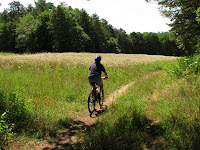Diana Lajoie admits to having a competitive streak so fierce that she usually declines to participate in anything she knows she can't win. She's even quick to end her favorite computer game of Yahtzee when it looks like it's not going well, opting instead to start a new game.

So it surprised the 38-year-old resident of Seekonk, Mass., as much as anyone when in 2004, at the urging of a couple of triathletes in the yoga class she taught, she decided to enter her first triathlon in Ashland, Mass., an Olympic-distance event that consisted of a swim of just under a mile, a 24.8-mile bike ride and a 6.2-mile run.
"I was delighted just to finish, and I got the bug," Lajoie said last week over dinner in Providence.
"Bug" might be a bit of an understatement. Since then, Lajoie estimates, she has competed in 10 Olympic triathlons, 4 sprints (consisting of a half-mile swim, a 12.4-mile bike ride and a 3.1-mile run), 2 "70.3s" or half-triathlons (a 1.2-mile swim, a 56-mile bike ride and a 13.1-mile run) and 3 Ironmans, the granddaddy of all triathlons, consisting of a 2.4-mile swim, a 112-mile bike ride and a 26.2-mile run.
In her last Ironman, in
Lake Placid, N.Y., on July 26, Lajoie placed 17th out of 104 in her division with a personal-best time of 12 hours, 1 minute and 21 seconds. (All of these photos, incidentally, are from the Lake Placid event.)
While happy to have posted her best time in Lake Placid, Lajoie felt she could have done better were it not for some issues that arose related to her race-day intake of food and liquids.
"Nutrition is everything," she said.

The problem began with a minor cramp in her right calf during the swim, she said. She fared very well during that portion of the event, finishing 10th in her division. The cramps escalated during the bike ride, Lajoie said, so she began drinking a lot of water at every aid station and dipping into all the nutrition she carried in her
Fuel Belt, "just like in training." She managed to finish strong in the bike ride, at ninth place in her division. But her troubles were just beginning.
"By the time I got to the run, the leg cramps were gone, but my stomach was upset," she said. "Thank God for Porta Johns. It was very challenging."

When such unforeseen troubles arise on the course, Lajoie said, "It becomes more of a mental race than a physical race."
Running has always been her weakest link in the event, Lajoie said, which is why she's planning to emphasize running in her training from October through February, perhaps participating in some 5Ks and 10Ks to work on her speed. But that will be for training purposes only.

"I love triathlon," she said. "I could never see myself just swimming, biking or running."
Her goal is to be invited to the most famous of all triathlons, the World Championship in Kona, Hawaii. "I think it is [the goal] for everyone," she said. Only the top three finishers in each division of an Ironman are invited to the Hawaii race, though the top 20 are kept on a list of potential invitees in case some cannot make it.
Because Lajoie finished 17th in her division at Lake Placid, she was honored to have her name on that list.
Lajoie said one of the most difficult things about running an Ironman, aside from the countless hours of training, is learning to pace herself. Being so competitive, it's hard, she said, to watch people pass her, but she has to resist the urge to try to keep up.
"The whole point is to find a pace that will be comfortable without burning yourself out," she said. "So many people leave themselves for dead on the run."

If there's one thing Lajoie hopes others will take from her story, it is that she has accomplished what she has as an ordinary woman. She did not have parents who pushed her along the way, she did not have a high-paid coach. She is truly self-motivated, having trained herself using plans downloaded from the Internet.
"I'm just a normal person," said Lajoie, who works as a CAT-scan technologist at
Rhode Island Medical Imaging. "Anybody can do this, whether running their first 5K, or doing the first one-mile walk that they've never done before."
There is a price to pay for the training required for Ironmans, though. Lajoie talks almost ruefully of the pre-dawn hours spent training alone, and the fact that she can never seem to find the time to go camping under the stars on a weekend with her husband.
"So you envy other people," she said. "The only time I sit still is when I hit the wall."
I'm thankful Diana took the time to sit still with me for a couple of hours, and I didn't get the sense that there was a wall anywhere in sight.
 I've always had mixed feelings about that popular self-help expression "fake it till you make it." While I'm sure that approach can help some people, it has always struck me as too trite to be of real value to those who are trying to make big changes in their lives.
I've always had mixed feelings about that popular self-help expression "fake it till you make it." While I'm sure that approach can help some people, it has always struck me as too trite to be of real value to those who are trying to make big changes in their lives. I also often hear people say — and I've been guilty of it, too — that after a day at work, they're too tired to work out.
I also often hear people say — and I've been guilty of it, too — that after a day at work, they're too tired to work out.










































